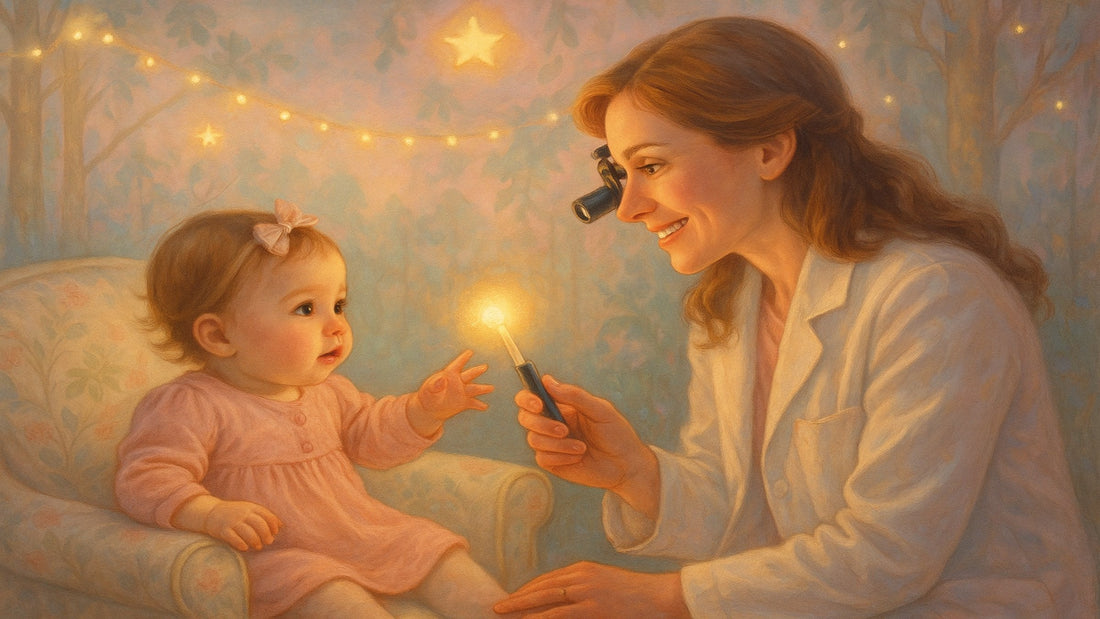
Why Your Infant Needs Vision Evaluation Sooner Than You Think
Share
Author: Hayley Martin
There’s a quiet kind of magic in the way a baby sees the world for the very first time. How her eyes flutter toward soft light, how she gazes at your face with wordless wonder, how the shapes and colors of her new world slowly come into focus.
But what if, behind that beautiful gaze, something isn’t developing as it should?
From tummy time to tracking little milestones that mark our babies' progress, hidden in the wonder of it all is something that is often overlooked, our babies' growing vision quietly unfolding on its own precious timeline.
At Once Upon a Charm, we believe in protecting vision before it becomes a struggle. And that means beginning earlier than most people think, as early as 6 months old.
Your baby’s eyes are learning just as much as her brain. By six months, essential visual skills like eye teaming, depth perception, and focusing are already developing. But if one eye isn’t working properly, or the two eyes aren’t working together, your baby may not show symptoms yet, even as deeper problems quietly take root.
Here’s the surprising truth.
Most pediatricians don’t test for functional vision issues. Routine baby checkups might catch big red flags, but not subtler challenges like amblyopia (“lazy eye”), eye misalignment, or extreme farsightedness.
That’s why scheduling a comprehensive infant eye exam with a pediatric or developmental optometrist is one of the most powerful choices you can make for your child’s early development.

A baby’s first eye exam is as gentle as a lullaby. No scary machines. No letter charts. Just curiosity, light, and play. A pediatric optometrist trained in infant care will guide you through a warm and engaging experience.
Here’s what to expect during your baby’s eye exam:
- A calm, cozy environment: Your baby may sit on your lap while the doctor softly speaks and engages her with toys or light.
- Eye tracking games: The doctor watches how your baby follows movement to assess tracking and attention.
- Binocularity and alignment testing: They check if your baby’s eyes are working together or if one is turning inward or outward.
- Refractive screening: With a handheld device, the optometrist checks for early signs of nearsightedness, farsightedness, or astigmatism.
- Internal health screening: The doctor gently examines the inner eye for any signs of disease or structural issues.
Most babies respond with interest, and sometimes even giggles. The entire appointment is non-invasive and lasts about 20 to 30 minutes.
Make the visit feel like a sweet little outing by planning ahead
- Choose the right time: Schedule when your baby is usually well-rested and alert, not just before a nap or feeding.
- Bring comfort items: A favorite blanket or toy can help your baby feel safe in a new setting.
- Dress for closeness: You’ll likely be holding your baby, so dress for cuddles.
- Ask everything and anything. Don’t hesitate to raise even the smallest questions, your optometrist is there to support you.
We know how overwhelming it can be to add one more thing to your list as a parent. But this one is simple, powerful, and completely free.
InfantSEE® is a national public health program designed to provide a free infant eye exam between 6 and 12 months of age. Created by the American Optometric Association Foundation, and supported by optometrists across the country, InfantSEE ensures that every baby has access to expert care, no matter their family’s insurance or income.
With InfantSEE, you can:
- Schedule a no-cost comprehensive eye exam with a participating optometrist
- Detect early signs of amblyopia, eye turns, or refractive error
- Support your child’s visual development before school years begin
You can search for a provider near you at www.infantsee.org. It's one of the most important steps you can take in protecting your child’s long-term learning, confidence, and joy.

One in four children has an undiagnosed vision problem, and many of those issues begin in the first year of life. The sooner they’re detected, the easier they are to treat (and often without surgery or complex intervention).
Conditions like amblyopia, strabismus, and extreme refractive errors are most treatable when caught before age 2. But they often go unnoticed until a child enters school and begins to struggle with reading, focus, or coordination.
We often say that vision is the window to learning. But truly, it’s also a mirror, reflecting how a child sees herself. A girl who can see clearly and comfortably is far more likely to feel brave, curious, and proud.
And that’s why Once Upon a Charm exists. To create magical glasses that support not just vision, but self-esteem.
What age should my baby have their first eye exam?
Experts recommend scheduling a comprehensive infant eye exam between 6 and 12 months old, when key visual development is underway.
How do I find a free eye exam for my baby?
Visit www.infantsee.org to find a participating optometrist in the InfantSEE program, which provides free baby eye exams across the U.S.
What if my baby seems to see just fine?
Even if your baby shows no signs of vision problems, many issues, like eye misalignment or farsightedness, aren’t noticeable to parents. A trained eye care provider can detect problems early, before they affect development.
Your baby’s first year is filled with so many firsts. Her first giggle, first roll, first look of recognition. Let her first eye exam be part of that journey.
Because when a child sees clearly, she sees more than the world. She sees her place in it.
